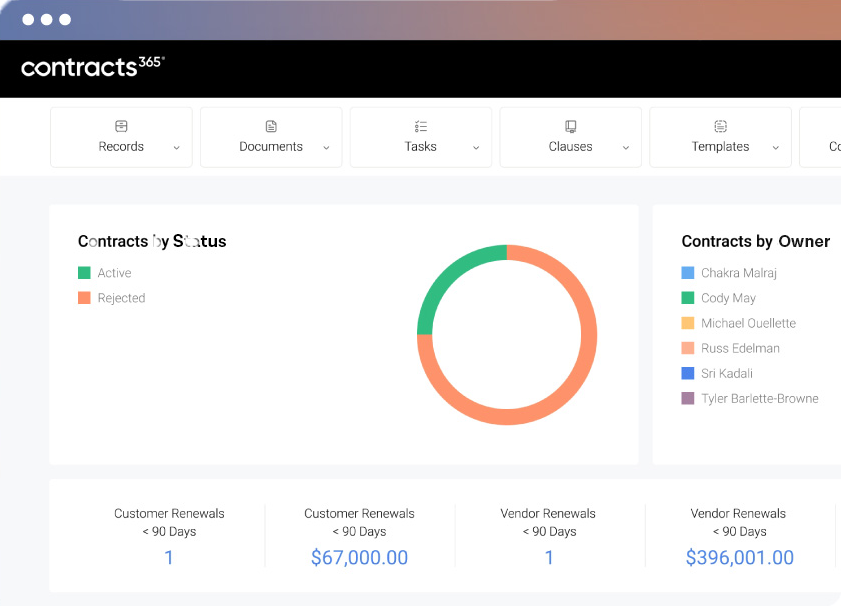Buy Side vs. Sell Side Contracts in Contract Lifecycle Management
Although there are many types of business contracts, the two main types are called Buy-Side Contracts and Sell-Side Contracts. The difference between a buy-side contract and a sell-side contract seems straightforward and contained within the terms. "Buy-side" contracts involve buying things while "sell-side" contracts are used to transact sales with your customers. But few things are as simple as they seem, especially in business. Although the two sides are different in their purpose, they share similarities that will be exposed as we dive deeper into the comparison.
What Are Buy-Side Contracts in Contract Lifecycle Management?
Buy-side contracts arrange to obtain goods or services from the seller in exchange for some consideration, such as money. The staff responsible for managing buy-side contracts at your organization most likely work in procurement, outsourcing, vendor management, facilities management, or some related department. Larger purchases often require a more thorough buying process which may include a request for proposal (RFP) or other more complicated vetting procedure.
5 Benefits of Immediate Access to Contracts for Buy Side Contract Management
- To negotiate the best possible price with vendors
- To recognize potential discounts in price within existing contracts
- To re-negotiate pricing or terms with current vendors
- To manage expenditures
- To ensure that the procured goods and services are delivered and paid for according to contract terms.
What Are Sell Side Contracts in Contract Lifecycle Management?
Sell-side contracts arrange for the sale and delivery of goods, services, or securities to a buyer. Staff most likely concerned with sell-side contracts are members of the sales team.
Staff involved in the sell side need immediate access to:
- Contract templates
- Existing contract information so they can sell new or additional goods and services
- Approved language for provisions and terms
- Current contracts to ensure the sold goods, licenses, and services are delivered and paid for according to contract terms.
Buy Side vs. Sell Side Contracts: Comparison of Differences and Similarities
Though there are distinct differences between buy-side and sell-side contracts in terms of focus since the buy side strives for cost reduction whereas the sell side seeks to enhance revenue streams, the two share several commonalities.
Both sides engage with third parties on behalf of the organization. Therefore, risk avoidance, compliance, and relationship management are important for both. Within an organization, key commonalities include:
- Information: The basic metadata of your company is constant. This includes counterpart signature details, addresses, and organization names.
- Processes: From a high-level view, approval processes likely are the same or similar. Most businesses require legal and financial review prior to executive approval.
- People: The people managing the contract once executed often are shared by both the buy and sell sides. These include legal staff, compliance officers, delivery personnel, accounting divisions, etc.
- Systems: The software and systems that feed into and come out of the contract creation and management overlap. For example, the same customer relationship management system likely tracks vendors as well as customers. The accounting software used to generate invoices from the sell side also issue payments for the buy side.
- Mission: Both sides work to advance the organization's mission and improve its business.
What This Means for Contract Lifecycle Management
Contract management uses many of the same processes, whether your focus is a buy-side or a sell-side. Though the inputs and outputs of these processes vary, the core elements of contract lifecycle management apply to both sides:
- Contract authoring and negotiation
- Financial management
- Performance management
- Relationship management
- Contract compliance monitoring
Well-designed and flexible contract lifecycle management software (CLM software) can work for the entire organization. The contract management software should have capabilities to house all contract types, all of which would benefit from the improved functionality in reporting and compliance with better-managed contract processes.
It makes sense to separate buy-side and sell-side departments within an organization, but it also makes sense to combine the two in one centralized management system to manage the obligations relating to buy-side and sell-side agreements. Containing all contracts under a single CLM software offers several advantages. You:
- Won't double your processes, which lessens the burden on shared departments such as administrative, IT, and legal.
- Pay for only one system.
- Streamline business intelligence and reporting to provide comprehensive data for strategic decisions.
- Have complete financial data for both expenditure budgeting and sales forecasting.
- Provide an executive-level view for visibility into every contract across the organization.
- Limit integration costs and training time.
- Organize documents into a central repository.
- Better manage relationships with third parties who might be both a supplier and a customer of your business.
- Align teams with shared data so an increase in sales triggers an increase in purchases of materials, for example.
It is common for an organization to initially implement a contract lifecycle management software solution for one high-priority use case. Once the return on investment is realized, or the enterprise-wide value of contract management becomes apparent, broader usage is considered. Whatever your implementation approach, leverage the benefits of contract lifecycle management software not limited to a buy-side or sell-side focus, so you are prepared for future requirements.
Contracts 365 –the Leading Contract Management Software for Microsoft 365 Customers
Contracts 365 is the leading contract management software for Microsoft customers. With usability, functionality, and security at the forefront of development, Contracts 365 addresses all aspects of the contract lifecycle through a modern, intuitive interface specific to your users. Customer First Cloud Architecture provides IT with the security of Microsoft 365 while powerful prebuilt integrations with Dynamics and Salesforce extend the platform to every part of your business. Please don’t hesitate to reach out to contact us or request a demo so we can show you how it all works.
